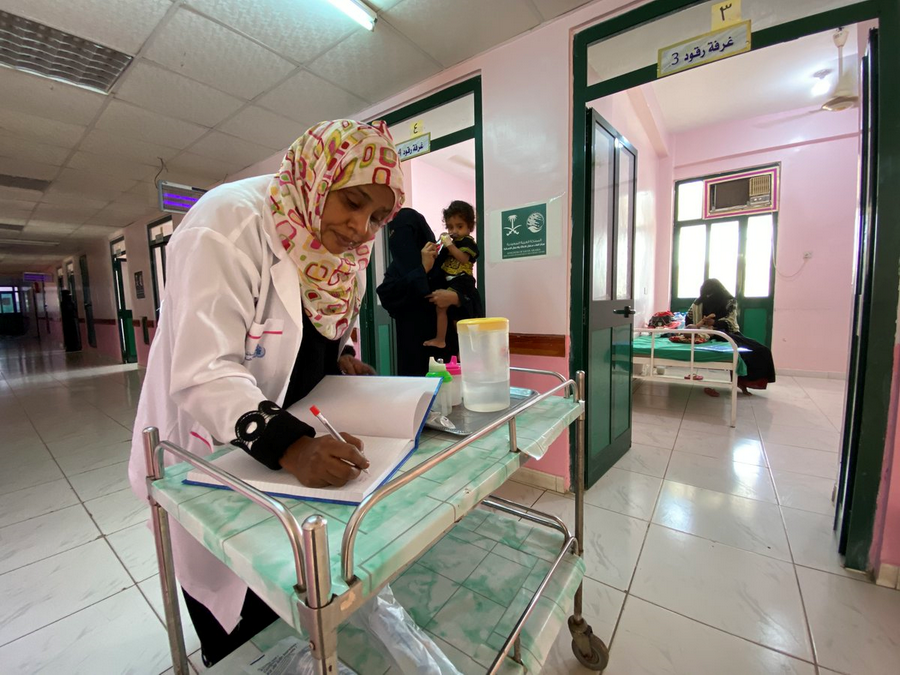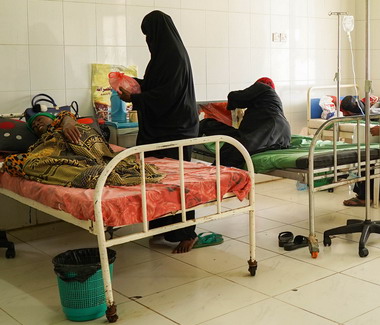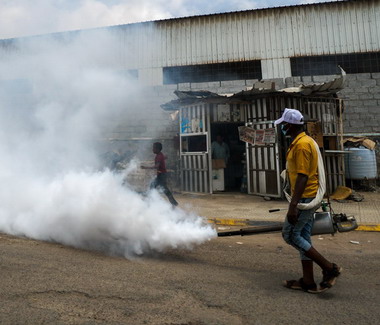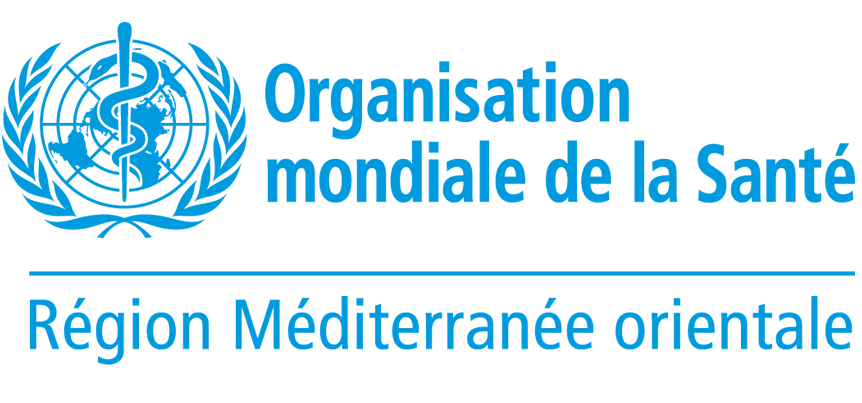WHO and KSrelief renew partnership to continue sustaining Yemen’s health system

Cairo/Riyadh, 20 September 2020 – The World Health Organization (WHO) and the King Salman Humanitarian Aid and Relief Centre (KSrelief) have renewed their partnership to continue sustaining the health system throughout Yemen.
The agreement, funded at US$ 46 million, includes support to essential health services, COVID-19 preparedness and response efforts and nutrition, water and environmental sanitation services across the county.
Thanks to this partnership, WHO will be able to facilitate the provision of a quality minimum service package to 25 hospitals serving 5.1 million beneficiaries. WHO will also work with health authorities and partners to strengthen preparedness capacity and enhance the capacity of heath staff and pre-hospital and referral care services.
In line with the established COVID-19 response plan, the support of KSrelief will enable WHO to support health authorities in establishing additional isolation units designed to treat patients with a severe or critical incidence of the disease. These will be equipped with the necessary resources, including medicines and ventilators.
The partnership will enable the provision of essential nutrition services in 90 therapeutic feeding centres, covering 222 high priority districts in Yemen's 22 governorates and providing treatment to 23 428 individuals and counselling to their caregivers. Of the 90 centres, 45 will be rehabilitated, and 13 will now become operational to enhance treatment and expand therapeutic feeding services in priority districts.
A project on improvement of water and sanitation services in 45 health care facilities and water quality monitoring and surveillance in high-risk districts will aim to improve health services and health preventive programmes provided at the hospital level, including care of newborns, elimination of childhood pneumonia and diarrhoea.
KSrelief has been the main funding partner of WHO in 2019–2020. Since October 2019, the partnership between the 2 organizations has helped preserve the health system in Yemen, including through ensuring access to health care for the vulnerable in remote areas through the provision of a minimum service package. It allowed WHO to facilitate the provision of lifesaving medicines, including treatment for patients with chronic, life-threatening conditions, such as kidney failure. The partnership has also supported child immunization programmes and assistance to pregnant women for safe birth deliveries.
This new generous contribution will enable timely support to Yemen in containing communicable diseases, including cholera and COVID-19, while preserving the delivery of essential health services.
About the humanitarian crisis in Yemen
Yemen remains the world's worst humanitarian disaster, and WHO's most complex operation. Some 24.3 million people – 80% of the population – now require humanitarian assistance or protection. More than 17.9 million people (out of the total population of 30 million) need health care services in 2020. At the same time, only half of the health facilities are fully functioning. Those that remain open lack qualified health staff, basic medicines, and medical equipment like masks and gloves, as well as oxygen and other essential supplies. WHO and partners are supporting health authorities in responding to the increasing health needs of the population. Still, unprecedented funding shortages are threatening the sustainability of critical, lifesaving programmes, putting millions of lives at risk. Though much has been accomplished, more needs to be done to secure Yemenis’ right to health and to save many more lives, now more than ever with the added burden and unprecedented threat of COVID-19.
For more information, please contact :
Inas Hamam
Communications Officer
Cancer patients in Yemen face the compounded pain of disease and conflict
 Maryam and Jamila receive treatment at a WHO-supported oncology centre in Aden
Maryam and Jamila receive treatment at a WHO-supported oncology centre in Aden
20 September 2020 – The pain of cancer patients in Yemen is being compounded by the additional burden of conflict, displacement, widespread poverty and hunger.
Jamila, a 40-year-old woman, is currently displaced due to the ongoing conflict. To add insult to injury, she has cancer.
“It’s difficult to find medicines nowadays, and the available ones are very costly. Being without income, I cannot afford them”, said Jamila, who has received free of charge cancer medicine provided by a WHO-supported cancer centre.
The ongoing conflict in Yemen has turned an already vulnerable country into the world’s largest man-made humanitarian crisis, taking away what its people need the most, including the fundamental needs, like health care. In 2020, more than 19.7 million people need health care services in Yemen while only half of Yemen’s facilities are still functioning. There are also about a total of 1.5 million currently displaced people, suffering from already existing vulnerabilities.
As the economy collapses and imports are restricted, medicines and equipment that are readily available in other countries are scarce in Yemen. As a result, treatment is available at only a fifth of Yemen’s health facilities.
Maryam, 60 years old, receives treatment at a WHO-supported oncology centre. “I have to travel for 350 km only to receive treatment. The transportation cost has skyrocketed, let alone accommodation.”
Approximately 35 000 Yemenis currently have cancer, and more than 11 000 are newly diagnosed with the disease every year. In 2016, many cancer clinics closed due to a lack of staff, medicines and equipment, creating long waiting times and forcing people to travel many miles for vital treatment. As a result, thousands face a death sentence through lack of access to medical care.
“There are so many things that people around the world take for granted, while they are beyond our reach in Yemen. As we struggle to get the most basic needs, our right to health and life is compromised,” said Maryam, who fears that her children would one day be unable to secure her treatment.
“In Yemen today, we are dealing with the real threat that patients face imminent and painful death unless we continue to receive the support that will enable us to save their lives,” stressed Dr Abdulwahab Al Nehmi, WHO Noncommunicable Diseases Officer.
WHO and partners, including the King Salman Center for Humanitarian Aid and Relief and Kuwait, are working to prioritize the procurement and delivery of supplies to cover the life-saving treatment needs for patients living with chronic, life-threatening conditions, including cancer. WHO has supported the national oncology centre with various life-saving anti-cancer medicines and chemotherapy medications, helping to save the lives of thousands of patients, and providing painkillers, such as morphine and fentanyl, to improve the quality of life for patients at advanced stages of the disease. WHO has also facilitated workshops on the early diagnosis of breast cancer, and mental health and psychosocial support for cancer patients. Thanks to the generous support of the donors, all cancer centres are currently open and providing cancer care across the country.
“Without WHO support with the cost of my treatment, I would have stayed home, waiting for death to relieve my pain,” said Maryam.
Dengue fever control campaign in Aden

14 September 2020 – A dengue fever control campaign that will cover the 8 districts of Aden city was launched on 13 September by the Ministry of Public Health and Population, with the support of the World Health Organization (WHO) and the King Salman Humanitarian Aid and Relief Centre (KSRelief).
The 4-day campaign will include indoor and outdoor fogging, community awareness activités, vector surveillance and environmental management of all mosquitoes breeding sources, providing direct protection to 430 000 people and indirectly to the 1.7 million total population of Aden city.
The campaign represents the second round of dengue control response in the city this year. A first round was conducted in May with the support of WHO.
Dengue is a mosquito-borne viral disease transmitted by female mosquitoes mainly of the species Aedes aegypti. It is endemic in the urban and semi-urban setting in the coastal areas of Yemen on the Red Sea and Arabian Sea. However, data collected in 2019 and 2020 showed that dengue was reported in 204 districts, including rural areas.
Early in 2020, once-in-a-generation flooding devasted southern communities in Yemen, including in Aden, resulting in the emergence of outbreaks, including dengue fever, malaria and chikungunya, all transmitted by mosquitos.
About the WHO-KSRelief malaria control and prevention project
In March 2020, WHO and KSRelief signed an agreement to support national response for malaria and dengue vector control and prevention in Yemen. An 18-month multidimensionnel projet has been built on 4 pillars:
- strengthening malaria diagnosis and treatment at public health facilities and community level;
- maintaining effective coverage of all populations at risk of malaria and dengue through implementation of suitable vector control interventions;
- strengthening surveillance activities, epidemic preparedness and response for malaria and other mosquito-borne diseases;
- strengthening national capacity to ensure the continuity of malaria control and prevention and to address the ongoing emergency and humanitarian crisis.
The 18-month project will serve more than 7 million beneficiaries.
Polio outbreak in Saada governorate
6 September 2020 – Fourteen cases of vaccine-derived poliovirus type 1 (cVDPV1) have been detected in several districts in Saada governorate, in the north-west of Yemen.
The cases – children aged from 8 to 156 months – had onset of paralysis ranging from 31 January to 18 June 2020, with one other case from June 2019 also confirmed retrospectively.
The 14 cases are clustered in an area with very low routine immunization levels that has been inaccessible to the polio programme since late 2018 for various reasons, including the restrictions due to the current COVID-19 pandemic, and has been a source of growing concern for those reasons.
Health authorities in Yemen, supported by the polio programme staff, and the regional teams of WHO and UNICEF, are working hard to mount an outbreak response rapidly.
Contacts of affected children are being traced, and every effort is being made to ensure more children have access to essential immunization.
Vaccination is the only way to protect children from polio, and the oral polio vaccine (OPV) is the best know tool for that. It is the tool used by the WHO’s polio programme to eradicate polio and protect populations from type 1 polioviruses, in Yemen and worldwide.
Note on the vaccine-derived poliovirus
Vaccine-derived poliovirus type 1 is a strain of poliovirus that emerges and paralyses children in communities where not enough children have received OPV. The term “vaccine-derived poliovirus” can be misleading: while the vaccine-derived strains can cause outbreaks of polio, these outbreaks are stopped by achieving high vaccination coverage by the same vaccines. For this reason, an outbreak of VDPV acts as an urgent warning signal that immunity levels in that area are dangerously low.








